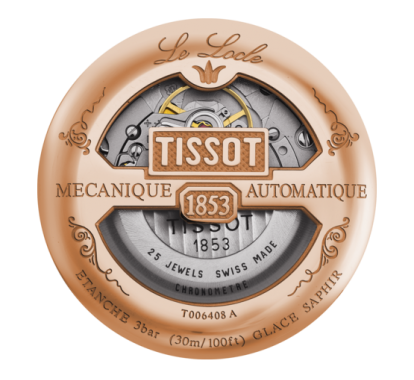Tissot is part of the SWATCH Group since 1983 and it has a history that goes back to 1853. The brand is based in the Swiss city of Le Locle, in the Neuchâtel area of the Jura Mountains.
An important virtue of Tissot is that they produce mechanical watches with COSC chronometrie certification. The “Contrôle Officiel Suisse des Chronomètres” is the Official Swiss Chronometer Testing Institute and is responsible for certifying the accuracy and precision of wristwatches in Switzerland. Many watchmakers and watch brands use the COSC certification as an assurance for the quality of their watches.
This is the case of the Tissot Le Locle Automatic Chronometre Ref. T0064083605700.
It’s sure that this piece is not a novelty but despite its age it always remains interesting.
Let’s have a look today at this beautiful and elegant Tissot.

This lovely classic watch from the Tissot Classic collection comes in a 39.3mm diameter rose gold PVD coated 316L stainless steel case. While the case is satin brushed, the bezel and the 19mm wide lugs are polished – this leads to a refined look but with a better scratch resistance for the side. The crown is 316L stainless steel with rose gold PVD coating and we will find the Tissot “T” logo embossed on it. The watch is covered with a scratch-resistant sapphire crystal on top and with a see-through case back decorated with traditional engraving motifs. This case is designed to withstand a pressure of up to 3 bar (30 m / 100 ft).
The black HMSD dial has the center guilloché pattern decorated with white Tissot logo and the founding year – 1853, on the upper side, at 12 o’clock. At the lower side are Tissot’s birth place and the proud inscription – Chronometer at 6 o’clock.
The dial uses baton applied polished gold coloured indexes for the hours with also Arabic numerals for 12, 3, 6 and 9 o’clock. The minute indexes are white painted and are placed outside the hour indexes. The Le Locle Automatic uses polished gold plated Feuilles hands for hours and minutes and has a Poire style hand for the seconds.
Did you know that even if watches usually have three hands showing the hours, minutes and seconds, the earliest watches had only an hour-hand. The English horologist Daniel Quare is believed to have introduced the minute-hand about 1691, though it did not come into general use until the early 18th century.
The date window, placed at 3 o’clock has a high contrast, black on white background, which fits well with the white writings of the dial.

Well to be honest, a white date window on a black dial remains an aesthetic mistake, but nevertheless, I don’t find it too disturbing on this piece … Sure that for some people this can be a real hinder, but there it’s just a question of taste.
Inside the Tissot Le Locle and visible on the back of the watch, is the Suisse automatic movement ETA2824-2 which is specially modified to comply with the COSC specifications: the average accuracy is between -4/+6 seconds per day – the watch is tested in various positions and at various temperatures, the water resistance is also tested, in the laboratory for 15 days and 15 nights.

The caliber ETA2824-2 is decorated with satin-brushed finishes, polished screws and it has a bi-directional rotor decorated with Côtes de Genève and personalized with the Tissot logo.
The 25.6mm (11½ »’) diameter self-winding movement has 25 jewels, Incabloc shock protection, a heart beating with 4Hz or 28800vph and it has a power reserve of 38 hours.
The Tissot Le Locle Automatic COSC comes with a grained calfskin leather strap with crocodile print and with a steel butterfly clasp with the Tissot logo engraved.
This lovely dress watch priced 1100€, can be a great day watch for someone who’s looking for a classical piece.
Visit the Tissot Website for more information.
Article written by our new contributor Andrei Kluska.

Nice job,I have a soft spot for the old school look.